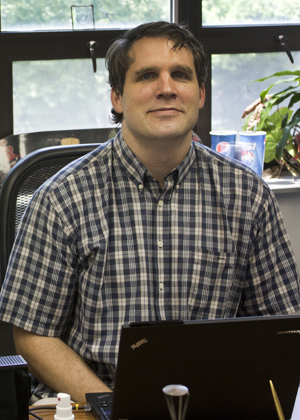Dr. Justin Frantz, Assistant Professor of Physics and Astronomy at Ohio University, on “What is the strongly coupled quark-gluon plasma and how does it form?” on Friday, Oct. 11, at 4:10 p.m. in Walter 245. His talk is part of the Physics and Astronomy Fall 2013 Colloquium series.
“The new state of matter discovered in Relativistic Heavy Ions indeed appears to be composed of deconfined quarks and gluons as hoped for,” Frantz says in his abstract. “However, one of the big experimental discoveries of the last decade has been that the phase transition sampled experimentally does not go straight from an ideal gas of hadrons to an ideal gas of quarks and gluons. Rather, another phase of deconfined matter appears which behaves more like a liquid with a viscosity that is the lowest ever observed in nature.
“This state has been termed the perfect fluid or the strongly coupled quark gluon plasma (sQGP). I will review the evidence for this, and especially focus on information made available from tracking high energy quark and gluon jets and non-interacting high energy photons as they traverse the sQGP. Especially, I will explain how, using this and other information, we are beginning to determine the detailed nature of the fluid state as well as the new interactions which must drive its formation.”
Remaining in the Fall 2013 series are held at 4 p.m. on Fridays at 4:10 p.m.
Oct. 18—Dr. Paul Debevec, University of Illinois, on “Understanding the Energy Challenge: Science, Technology, Economics and Policy.”
Oct. 25—Dr. Brian McNamara, University of Waterloo, on “Outflows from Supermassive Black Holes.”
Nov. 1—Dr. Hilmi Volkan Demir, of Nanyang Technological University, Singapore and Bilkent University, Turkey, on “Nanocrystal Optoelectronics for Quality Lighting”
Nov. 8—Dr. John Kopchick, Professor of Molecular Biology at Ohio University, on “Growth Hormone, Mini-mice, Football, Dirty Shorts and a New Drug.”
Nov. 15—Duncan Lorimer, of West Virginia University, on “Fast Radio Bursts: a new cosmological course population?”
Nov. 22—Jairo Sinova, of Texas A&M University, on “New Twists in Spintronics: anomalous Hall effect, spin-helix transistors and topological thermoelectrics.”
Dec. 6—Chang Kee Jung, on SUNY Stony Brook, on “Neutrino Oscillations from T2K.”
















Comments